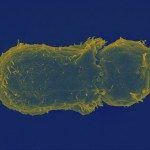Link to Pubmed [PMID] – 9257831
J. Immunol. 1997 Aug;159(4):1703-10
T cell activation by peptide/MHC complexes, superantigens, or mAbs induces the down-regulation of cell surface TCRs. We addressed the question of whether TCR down-modulation affects only TCRs that had directly interacted with their ligand or whether down-modulation could also affect TCRs that had not interacted with their ligand. To this end, we generated T cells coexpressing equal levels of two different TCRs by transfecting the appropriate cDNAs into cells of the human T cell line, Jurkat. Each set of TCRs can be distinguished by means of anti-Vbeta mAbs and can be stimulated separately with peptide Ag, bacterial superantigens, or mAbs. We found that activation of these cells with each of these stimuli down-modulated not only directly stimulated TCR complexes but also unstimulated ones. Comodulation of stimulated and unstimulated receptors may reflect functional interactions between surface TCRs that could take place during Ag or superantigen recognition by T cells without the need for ligand cross-linking. Consistent with this idea, both stimulated and unstimulated receptors colocalized in patches on the cell surface after activation.

